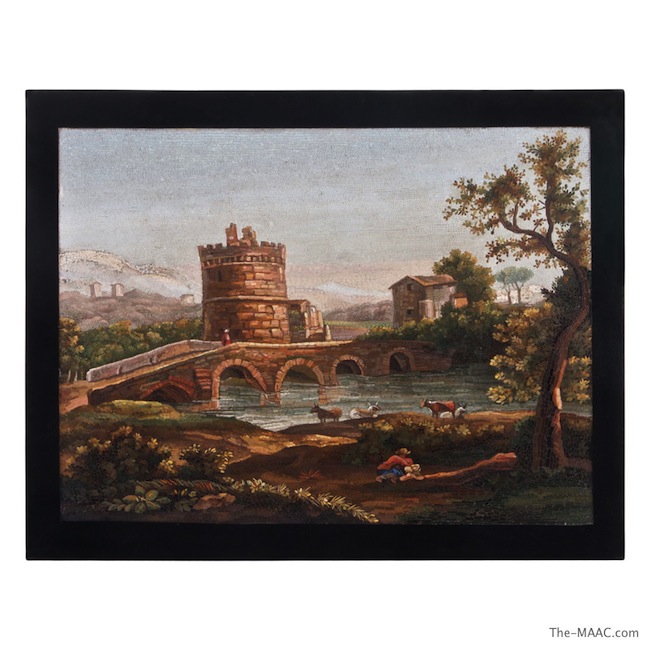
Micromosaic panel of Castle of Saint Angelo. Italy, 19th c. 8″ x 10-1/4″. Samuel Saidian Works of Art.
Soon after the sumptuous St. Peter’s Basilica was erected around 1600, a crisis arose: damp clouds began to form on the vast interior walls, ruining the altar paintings of the most famous artists of the day. Seeking a solution to the decay of time, Vatican artists noted the longevity of ancient Roman architectural mosaics, and thus began to experiment with modifying those techniques. Over the years, they developed 28,000 hues of very small tesserae, oblong pieces of enamel that can retain the appearance of painting, and by 1770, had used them to replace nearly all of the basilica art. Today, many visitors aren’t aware that the masterworks they’re gazing at are micromosaics, not paintings.

A micro mosaic panel on wooded frame showing a view of ancient Rome, including the Roman Forum, Palatine Hill, the Temples of Saturn and Castor and St. Peters in the background. Italy, 19th c. 5 3/4″ x 12″. Samuel Saidian Works of Art.
The Vatican has kept its own formula for making tesserae secret for over 200 years, but by the early 1800s, commercial mosaic studios began to open throughout Rome as well as a growing tourist demand for micromosaic mementos of the ancient ruins they had seen. The average tourist could only afford micromosaic pillboxes or paperweights while elaborate tabletops, jewelry and pictures were bought by aristocratic European travelers.

Detail of panel above.
The most finely worked panels of micromosaics contained as many as an incredible 3,500 to 5,000 tesserae. Sadly, the booming tourist trade that popularized the art eventually led to its demise. Generally, the public didn’t discern the level of craftsmanship required to make the pieces and by the end of the 19th century, artisans were using larger pieces of tesserae to save time and make the souvenirs more affordable. Like the Rome often depicted in them, true micromosaics became a thing of the past. Tourists can still buy micromosaics in Rome but pieces of the delicacy found in this post are no more.

Micromosaic of St. Peter’s Square. Italy, 19th c. 12″ x 14″ Samuel Saidian Works of Art.
 Micromosaic tortoiseshell and gold snuff box. Italy, c. 1870. 3.2″x 2.4″. Samuel Saidian Works of Art.
Micromosaic tortoiseshell and gold snuff box. Italy, c. 1870. 3.2″x 2.4″. Samuel Saidian Works of Art.

Micro mosaic box, wood. Italy, 1840. 2″ x 2 3/4″ x 1/2″. Michael’s Antiques.







